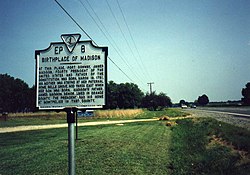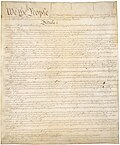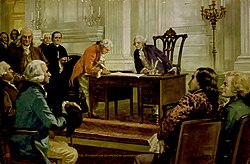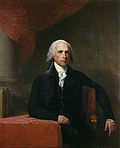James Madison
James Madison Jr. (March 16, 1751 – June 28, 1836) was an American Founding Father and the fourth president of the United States from 1809 to 1817. He was also the most important author of the United States Constitution and a slave owner with a large plantation.[1]
James Madison | |
|---|---|
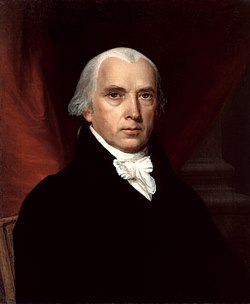 Portrait by John Vanderlyn, 1816 | |
| 4th President of the United States | |
| In office March 4, 1809 – March 4, 1817 | |
| Vice President |
|
| Preceded by | Thomas Jefferson |
| Succeeded by | James Monroe |
| 5th United States Secretary of State | |
| In office May 2, 1801 – March 3, 1809 | |
| President | Thomas Jefferson |
| Preceded by | John Marshall |
| Succeeded by | Robert Smith |
| Member of the U.S. House of Representatives from Virginia | |
| In office March 4, 1789 – March 4, 1797 | |
| Preceded by | Constituency established |
| Succeeded by | George Hancock (5th) John Dawson (15th) |
| Constituency | 5th district (1789–1793) 15th district (1793–1797) |
| Delegate from Virginia to the Congress of the Confederation | |
| In office November 6, 1786 – October 30, 1787 | |
| Preceded by | Seat established |
| Succeeded by | Cyrus Griffin |
| In office March 1, 1781 – November 1, 1783 | |
| Preceded by | Seat established |
| Succeeded by | Thomas Jefferson |
| Personal details | |
| Born | March 16, 1751 Port Conway, Virginia, U.S. |
| Died | June 28, 1836 (aged 85) Montpelier, Virginia, U.S. |
| Nationality | American |
| Political party | Democratic-Republican |
| Height | 5 ft 4 in (1.63 m) |
| Spouse(s) | Dolley Todd Madison |
| Religion | Episcopal Church |
| Signature | |
Madison was the shortest president in American history, with a height of 5 ft 4 in (1.63 m).[2]
Family
James Madison Jr. was the eldest son of Colonel James Madison Sr. and Nellie Conway Madison.
Madison married Dolley Todd (née Payne) on September 14, 1794 at the age of 43.[3]
Political life
Madison started his career in the Virginia legislature. Madison learned many things from Thomas Jefferson. Madison wanted a stronger federal government than the Articles of Confederation provided. He was a member of the Constitutional Conventtion, which formed the current United States Constitution. Madison is called the "Father of the Constitution" because he helped write a large part of it and convinced people to pass it.
Madison was elected to the House of Representatives. Madison helped write the first laws for the United States. Madison also was the main writer of the Bill of Rights, the first ten amendments to the Constitution.
Madison and Jefferson were good friends and helped create the Democratic-Republican Party, which wanted a weak federal government.
Madison was selected by President Jefferson to be his Secretary of State.[4]
Presidency
Madison was selected by his political party to be the Democratic-Republican candidate for president in 1808. He won that election and was re-elected in 1812.[5]
The War of 1812 started while Madison was president. Madison still hoped for peace, but Congress wanted war and so he gave in, and the 61-year-old president approved a declaration of war against Britain on June 19, 1812. People who still wanted peace called it "Mr Madison's War."
Madison and his family were forced to flee in 1814 when British forces seized control of Washington, D.C., and burned the White House and many other buildings to the ground. Dolley Madison, his wife, famously saved a portrait of George Washington from the fire.[6]
The war caused Madison to want a stronger government than he had before. While he originally was against a national bank, he decided that it was necessary to fund a war. After the charter of the First Bank of the United States expired, Madison recreated it.[7]
Later life
Madison retired to Virginia after his second term. He died there from heart failure on June 28, 1836 at the age of 85.[8]
James Madison Media
Madison as a student at Princeton, portrait by James Sharples
Madison's portrait as congressional delegate at age 32 when he was already recognized as a contributor to politics and government. Portrait by Charles Willson Peale 1783.
First page of the original handwritten copy of the U.S. Constitution
George Washington witnesses Gouverneur Morris sign the Constitution while Madison sits in front of Benjamin Franklin and next to Robert Morris in John Henry Hintermeister's 1925 painting, Foundation of the American Government.[9]
Thomas Jefferson founded the Democratic-Republican Party with Madison and broadly represented Southern interests.
Dolley MadisonPainted by Gilbert Stuart c. 1804
The 1803 Louisiana Purchase totaled 827,987 square miles (2,144,480 square kilometers), doubling the size of the United States.
James Madison as Secretary of State painted by Gilbert Stuart, c. 1805–1807
References
- ↑ Spies-Gans, Marcelo Sanchez. "James Madison". Princeton & Slavery. Retrieved 2020-10-27.
In February 1801 Madison Sr. died, leaving Montpelier and more than one hundred slaves to James Madison, as his eldest son. The following week, Thomas Jefferson became President of the United States and appointed Madison as his Secretary of State. Madison managed Montpelier from afar, yet took no concrete steps toward freeing his slaves or changing the plantation system. Upon becoming the fourth President of the United States in 1809, Madison brought slaves to serve him in the White House. One of these slaves was ten-year-old Paul Jennings, whose memoir about White House life—A Colored Man's Reminiscences of James Madison—was published in 1865.
- ↑ "James Madison". NPS.org. Retrieved November 4, 2013.
- ↑ "James Madison | Biography, Founding Father, & Presidency". Encyclopedia Britannica. Retrieved 2021-08-14.
- ↑ "James Madison". HISTORY. Retrieved 2021-08-14.
- ↑ "James Madison". The White House. Archived from the original on 2023-09-29. Retrieved 2021-08-14.
- ↑ "James Madison". Biography. Retrieved 2021-08-14.
- ↑ "James Madison - People - Department History - Office of the Historian". history.state.gov. Retrieved 2021-08-14.
- ↑ "'Father of the Constitution' James Madison Dies, 1836". NewseumED. Retrieved 2021-08-14.
- ↑ Robinson 1999, p. 117.
